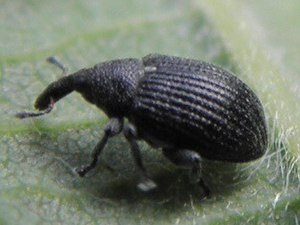Anoplus
| Anoplus | ||||||||||||
|---|---|---|---|---|---|---|---|---|---|---|---|---|

Anoplus roboris |
||||||||||||
| Systematics | ||||||||||||
|
||||||||||||
| Scientific name | ||||||||||||
| Anoplus | ||||||||||||
| Germar , 1820 |
Anoplus is a genus of the weevil family . A key distinguishing feature from other European weevil genera is the lack of the fourth tarsal link .
features
They are small beetles with a body length of 1.5–2.5 mm (without proboscis). The body is completely black, only the antennae can be partly reddish. The top of the elytra can be short and black-haired or have sparse white scale hair. The trunk cannot be placed on the underside. The antenna whip consists of 7 parts. The front hips collide. The thighs are imperforated.
Characteristic of the genre are the tarsi on distal , so outer-facing end of the legs, which lack the jaw member including claws. They are tripartite, with the 3rd link being slightly expanded. This clearly distinguishes the genus from all European weevils.
biology

The larvae of all species live as leaf miners in the leaves of various deciduous trees, especially birch , alder and hazelnut . The eggs are usually laid in the spring near the midrib in the front part of the leaf. The mine is then eaten forward in an arc, often killing off the parts of the developing leaf that lie behind it. The mine itself widens somewhat, but remains without a branch. Most of the excrement left behind forms a clear black center line. The larvae leave the mine and pupate in the ground.
The adult beetles are found in Central Europe mostly in May and June on their host trees. They also feed on the leaves and leave numerous small round feeding holes.
Taxonomy
The genus Anoplus was established by Ernst Friedrich Germar in 1820 , with one species ( Anoplus plantaris ) previously described as Curculio plantaris .
Due to the striking unique selling point of the 3-part tarsi, the genus was the only one to be placed in its own subfamily Anoplinae. After the reorganization of the supragerian taxa in the family of weevils, it now belongs to the tribe Anoplini in the subfamily Curculioninae . In the meantime, two other genera, Thamnobius and Sphinxis , whose tarsi are normally formed, but apart from that have great resemblance to Anoplus, have been placed in this tribe.
distribution
The genus is distributed throughout the Palearctic from Portugal to Japan.
species
The genus currently consists of 4 species:
As of February 19, 2020
- Anoplus japonicus Morimoto, 1983
- Anoplus plantaris Næzén, 1794
- Anoplus roboris Suffrian, 1840
- Anoplus setulosus Kirsch, 1870
Web links
Individual evidence
- ↑ H. Freude, KW Harde, GA Lohse (editor): Die Käfer Mitteleuropas. Volume 11. Goecke and Evers Verlag, Krefeld 1983, ISBN 3-87263-031-8 . 8. Genus Anoplus on p. 283.
- ↑ Martin Hering: Collecting and breeding leaf-mining beetles. Coleopterological Rundschau Vol. 16 (No. 3/4) August 1930, pp. 127-137.
- ↑ Parasites of Europa : Anoplus plantaris
- ↑ P. Boardman: Shropshire weevils . Retrieved February 19, 2020
- ↑ VV Zherichen & AB Egorov: Weevils of the Far East USSR. Vladivostok 1990.
- ↑ H. Kojima, K. Morimoto: Systematics of the Genus Sphinxis Roelofs (Coleoptera: Curculionidae). Entomological Science 3, 3, 2000, pp. 529-556.
- ↑ Alonson-Zarazaga et. al .: Cooperative Catalog of palearctic Coleoptera Curculionoidea. Monografias Electrónicas SEA 8, Sociedad Entomológica Aragonesa SEA, Zaragoza 2017.